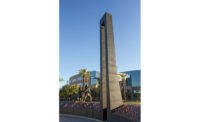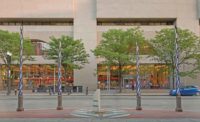The Melrose neighborhood, located in downtown Phoenix, has a unique identity that features a mid-century modern aesthetic throughout the community, including its retail spaces and antique shops running along Seventh Avenue.


However, area merchants wanted to create a gateway that would demarcate the area for visitors. After an extended period of fundraising, the local merchant's association and the city commissioned Gensler to design and coordinate construction of an "urban portal" across Seventh Avenue, which is six lanes wide.
"The goal was for people to know that they were entering a special place," says Jay Silverberg, principal with Gensler. "It had to be something iconic and special and simple."
After extensive discussions with area merchants, the city and several utilities, Gensler began working on a design. Eventually, designers developed a "pattern based off an organic form" that appears to emulate steel-hewn ivy, Silverberg says. To boost the structure's organic feel, the steel is naturally rusted, he adds.
Crews with steel subcontractor Bell Steel worked 24 hours a day over the course of two weeks to perform the plasma cutting of each unique 1/2-in.-thick steel panel on the 80-ft-wide arch, based on Gensler's designs for the decorative pieces. The firm's design required each steel piece to vary in shape, with the holes and features at the top and center of the structure notably bigger than the pieces closer to street level, which were tighter. The inside of the structure is black to provide an impression of additional depth.
During the fabrication stage, matching up Gensler's designs for the decorative steel pieces with Bell Steel's plasma-cutting machines was a major challenge, according to Silverberg.
"It's one of those projects that looks really simple, but it is very technologically complex," he says.
With its treatment of the Melrose name across the top of the structure, the designer also created a brand for the neighborhood by emphasizing in pink the "Melrose curve," which illustrates Seventh Avenue's alignment. In all, it took the project team roughly three months to design and fabricate the project off site.
The Weitz Co., the project's general contractor, oversaw the structure's assembly and erection and coordinated its installation with the city of Phoenix, Silverberg says.
Contractors used two 90-ton cranes, positioned on either side of the street, to install the gateway structure's 55-ton main truss. But first, erection crews used each crane to position and set the two columns. Then, for the tandem pick, each crane picked an end of the 80-ft-long truss, carefully maneuvering it for a 90-degree turn, and setting it on the columns for permanent connection. According to the contractor, the entire installation took place in just two hours.
"We installed this thing in one night," Silverberg says. Additionally, Weitz provided five field superintendents for the installation.
Best Projects judges rated the Melrose Gateway high for its "coolness factor." Additionally, they lauded the project team for creating something beyond the norm and for using old materials in new ways.
Melrose Gateway
Phoenix
Key Players
General Contractor The Weitz Co., Phoenix
Owner/Developer The City of Phoenix
Lead Design Firm Gensler, Phoenix
Structural Engineer PK Associates, Phoenix
Civil Engineer Aztec Engineering, Phoenix
MEP Engineer Henderson Engineering, Phoenix
Subcontractors Airpark Sign and Graphics, Tempe, Ariz.; Bell Steel, Phoenix




Post a comment to this article
Report Abusive Comment